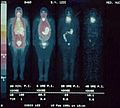Iodine deficiency facts for kids
Quick facts for kids Iodine deficiency |
|
|---|---|
| Classification and external resources | |
| Specialty | Endocrinology |
| ICD-10 | E00.–E02. |
| DiseasesDB | 6933 |
| eMedicine | med/1187 |
| Patient UK | Iodine deficiency |
Iodine deficiency happens when your body doesn't get enough iodine. Iodine is a very important mineral that your body needs to work properly. It's an essential nutrient you get from your food.
Not getting enough iodine can cause health problems. One problem is a goiter, which is a swollen thyroid gland in your neck. In severe cases, especially in babies, it can lead to a condition called cretinism. This can cause problems with a child's growth and brain development. Iodine deficiency is a major public health concern. The good news is that it's a problem we can prevent. It is the most common preventable cause of intellectual disability worldwide.
Contents
Why Iodine is Important
Iodine is a key mineral for your body. It is especially important for your thyroid gland. This gland uses iodine to make thyroid hormones. These hormones control many important body functions. They help with your growth and how your body uses energy. Without enough iodine, your thyroid can't make enough hormones. This can slow down your body's processes.
Where We Find Iodine
Iodine is found naturally in some foods. It is often found in seafood because the ocean contains iodine. So, fish and other foods from the sea are good sources.
However, iodine levels in soil can be low in some places. This means plants grown there won't have much iodine. Areas far from the ocean, or mountainous regions, often have iodine-poor soil. This is why iodine deficiency is more common in these inland places. People living there might not get enough iodine from their local food.
How to Prevent Iodine Deficiency
The best way to prevent iodine deficiency is to make sure people get enough iodine. A common and easy way to do this is by adding iodine to table salt. This product is called iodized salt. Just a small amount of iodine in salt can make a big difference.
Iodine compounds have also been added to other foods. These include flour, water, and milk in areas where people don't get enough iodine. Eating seafood is also a great way to get iodine.
Iodine Deficiency Around the World
Iodine deficiency is a global issue. In 2010, about 187 million people worldwide had a goiter because of iodine deficiency. That's about 2.7% of the world's population. Sadly, it led to 2,700 deaths in 2013. This number was up from 2,100 deaths in 1990. Efforts to provide iodized salt have helped reduce these numbers.
Images for kids
See also
 In Spanish: Deficiencia de yodo para niños
In Spanish: Deficiencia de yodo para niños



